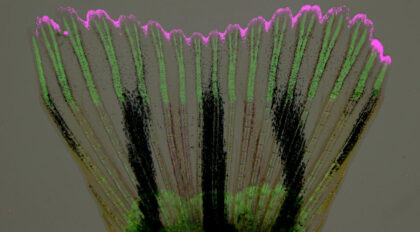How and why tissue regeneration does (or does not) occur are critical questions. The biology of regeneration remains both challenging and fascinating, and new discoveries have the potential to impact clinical outcomes of many diseases of organ damage, including heart failure, Alzheimer’s disease, and diabetes.
It has been known for centuries that salamanders and fish regenerate complex tissues much more effectively than mammals. Zebrafish have emerged as a central model system for studying regeneration, due to their ability to regenerate myriad tissues and to the availability of molecular genetic tools. Over the past 2 decades, our laboratory has spearheaded the use of zebrafish to reveal concepts and mechanisms of regeneration.
We study the initial morphogenesis and injury-induced regeneration of several tissues in zebrafish. Our student and postdoc projects investigate regeneration of heart, fins, spinal cord, skin, scales, kidney, and other tissues. We have also begun to test ideas in mammalian models.




